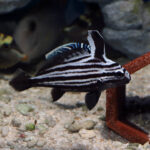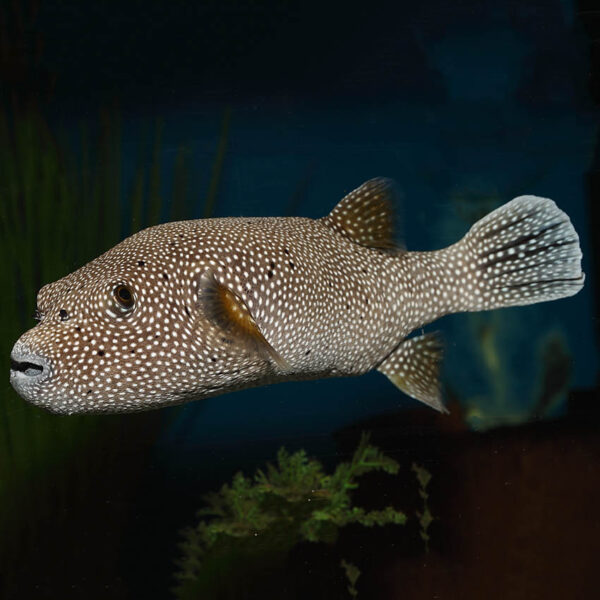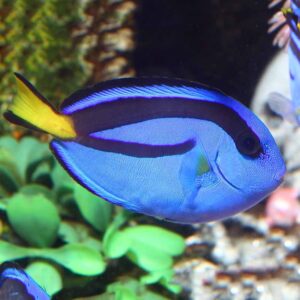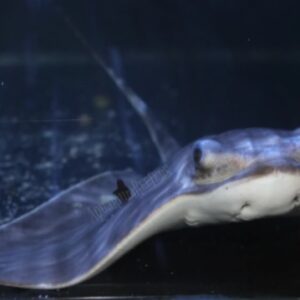Description
The Guineafowl Puffer (Arothron meleagris) is a medium-sized pufferfish, reaching a maximum size of around 18 inches (45 centimetres). It has a rounded body with distinct white spots on a dark background.
Taxonomy
The Guineafowl Puffer belongs to the family Tetraodontidae, which includes various species of pufferfish. Its closest relatives within the genus Arothron include the Map Puffer (Arothron mappa) and the Stars and Stripes Puffer (Arothron hispidus). The scientific name “meleagris” is derived from the Latin word for guinea fowl, referring to the fish’s spotted pattern.
Natural Habitat
In its natural habitat, the Guineafowl Puffer is typically found in coral reefs and lagoons, where it seeks shelter among rocks and crevices. It inhabits tropical and subtropical waters of the Indo-Pacific region.
Keeping Guineafowl Puffer Healthy:
Keeping the Guineafowl Puffer healthy requires a moderate level of care and difficulty. It is important to provide a spacious tank with plenty of hiding places, as well as maintaining stable water parameters.
Special Requirements and Feeding
The Guineafowl Puffer is an omnivorous species that requires a varied diet. It should be fed a combination of meaty foods such as small crustaceans, mollusks, and fish, as well as vegetable matter like seaweed and algae.
How Many Should I Keep?
The Guineafowl Puffer is best kept individually or in a mated pair to avoid aggression between individuals.
Natural Defence
When threatened, the Guineafowl Puffer has the ability to inflate itself by ingesting water or air, making it appear larger and deterring potential predators.
Lighting Preference
The Guineafowl Puffer does not have specific lighting preferences and can adapt to a range of lighting conditions in the aquarium.
Suitable Tank Mates
It is important to choose suitable tank mates for the Guineafowl Puffer as it may show aggression towards other fish, especially those with similar body shapes or smaller size. Compatible tank mates include larger, non-aggressive species that can hold their own.
Breeding: Arothron meleagris:
- Set up:
Breeding Arothron meleagris requires a spacious and well-maintained aquarium with suitable hiding places and appropriate water conditions.
- Courtship/ Spawning:
During courtship, the male pufferfish will display and engage in a series of elaborate swimming patterns to attract the female’s attention. Once the female is receptive, spawning takes place, with the male releasing sperm and the female releasing eggs simultaneously.
- Rearing:
After spawning, it is essential to promptly remove the eggs from the main tank to protect them from being consumed by the parents or other tank mates. The eggs are typically small and adhesive, attaching to a substrate or floating freely. They require specific water conditions and gentle aeration for successful incubation.
Sexual Dimorphism
Sexual dimorphism in the Guineafowl Puffer is not prominent, and it is challenging to differentiate between males and females based on physical characteristics alone.
Distribution
The Guineafowl Puffer is a naturally occurring species found in the Indo-Pacific region, including areas such as the Maldives, Indonesia, and the Philippines. It is important to note that while captive-bred and line-bred strains of this species may exist, the original fish in the wild come from the aforementioned regions.
Summary
The Guineafowl Puffer, scientifically known as Arothron meleagris, is a captivating and sought-after species in the aquarium trade. With its distinctive spotted pattern, it adds visual interest to any aquarium. It requires moderate care and is best suited for experienced fish keepers due to its delicate nature and potential aggression towards tank mates. Providing appropriate tank conditions, a varied diet, and suitable tank mates are essential for maintaining the health and well-being of this species. These fish exhibit interesting reproductive behaviours in the wild, with courtship and spawning being key components of their breeding process. While sexual dimorphism is not pronounced, males may display more vibrant colours during courtship. The species is naturally distributed in the Indo-Pacific region, originating from areas such as the Maldives, Indonesia, and the Philippines.
The Fish pictured here are representative only and the livestock you receive may vary in pattern, coloration, and shape.









Reviews
There are no reviews yet.